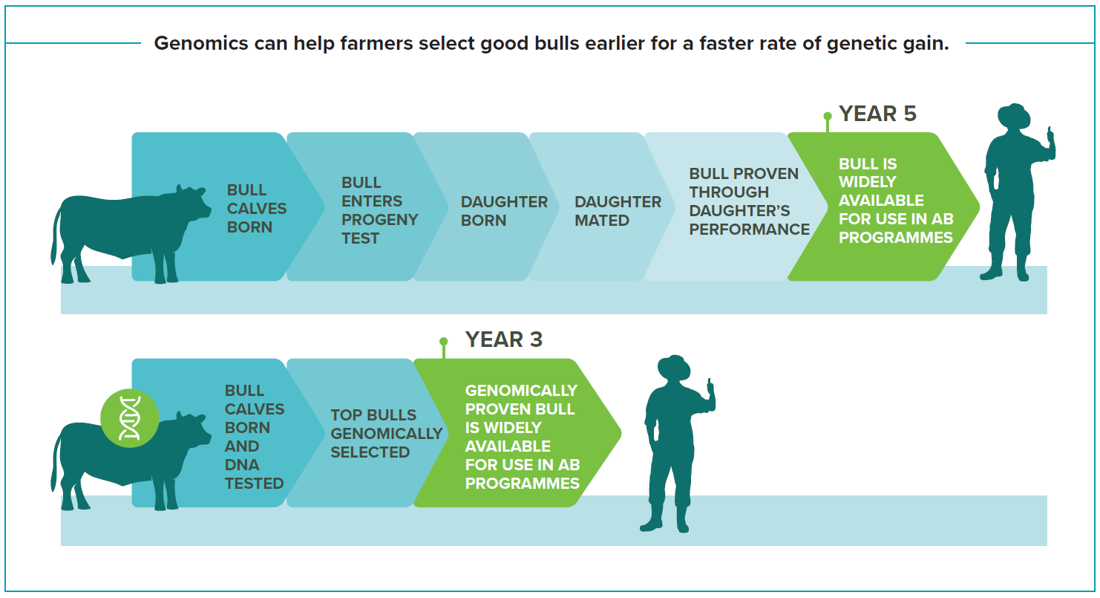Genomics
2 min read
Genomics is the use of DNA to predict the future potential and profitability of dairy animals. This page explains how adding genomic information to your animal evaluations can guide you in making better breeding decisions, leading to quicker genetic gain in your herd. Genetic gain is the improved performance or quality of a population due to selective breeding. Genomics lets you identify superior animals at a young age and breed them for more desirable traits such as higher milk production, increasing productivity, profitability and sustainability. You can get genomic information through DNA testing by working with providers such as your breeding company.
Genomics is the breeding of dairy animals using genotypes (DNA) to predict an animal's future potential for future profitability.
It is the study of all of an animal’s genes; examining how the genes interact to influence the animal’s development and growth.
Using traditional animal evaluation methods of phenotypic data, for cows we have an idea of the traits from her parents, but we are dependent on her production information to determine how reliable this information is. Genomic information can better predict which production qualities an animal has inherited and provide a much more reliable Breeding Worth (BW) at a younger age.
Genetics and environment are equally important in shaping an individual's phenotype (physical traits). The genetic component determines the potential for certain traits, while the environment can either enhance or suppress the expression of those traits.
Adding genomic information to your animal evaluations can help you make strategic breeding decisions to achieve faster genetic gain in your herd.
Genetic gain is the improvement in performance or quality of a population because of selective breeding or genetic improvement programmes. Genetic gain is achieved by selecting individuals with the most desirable traits, such as higher milk production in dairy cattle, and breeding them with each other to create offspring with superior genetic characteristics.
A higher rate of genetic gain means that the population will produce more offspring with the desired traits in a shorter period of time. This can lead to higher productivity, increased profitability, and improved sustainability of the production system.

Because we can pinpoint good bulls sooner, farmers can achieve a genetic gain faster in their herd when they use genomic-tested bulls in their breeding programme.
Broader use of genomic information in breeding programmes will help increase the rate of genetic gain for all kiwi farmers.
Find out more by visiting our Better Breeding Worth page.
Genomics helps farmers pinpoint their highest potential BW animals at a younger age to drive a high-performing herd best suited to their individual breeding objective.
Genomic technology provides powerful tools for improving genetic selection and breeding decisions. Here are some ways in which genomic technology can improve dairy cattle breeding programs:
Overall, genomic technology has the potential to greatly benefit the dairy industry by improving animal health, productivity, and sustainability, while also reducing costs and improving profitability for farmers.
Your animal is tested from a sample, generally a tissue punch, which is analysed by a laboratory.
You can work with providers such as LIC, CRV, Samen NZ Ltd, STgenetics, Semex and World Wide Sires NZ to obtain genomic information through DNA testing for your herd.
Now’s the perfect time to check in, plan, and set up for a strong season. We’ve pulled together smart tips and tools to help you stay ahead all winter long.
Whether you prefer to read, listen, or download handy guides, we’ve got you covered with trusted tools to support your journey every step of the way.
Put our proven strategies and seasonal tools to work. Boost production, support animal health and watch your profits hum.
Tools that are backed by science, shaped by farmers and made for this season.
That’s Summer Smarts.